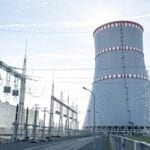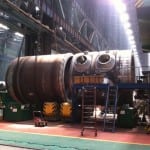The first reactor of the first nuclear power plant in Belarus was connected to the grid on Nov. 3. The Belarusian Nuclear Power Plant, also known as the Astravets plant, will have two operating reactors with a total 2.4 GW of generation capacity when completed in 2022, according to its current timeline.
The plant has overcome construction delays and continued opposition from neighboring Lithuania. Government officials in Lithuania have long expressed safety concerns about the plant, which is being built and financed by Rosatom, Russia’s state-owned nuclear company. Lithuania’s Litgrid power operator, to comply with a law banning imports of electricity from Belarus once the Astravets plant came online, cut the inflow of power from Belarus when the plant began operating.
The Belarusian energy ministry has said the plant when fully operational will supply about one-third of the country’s electricity requirements. Unit 1 is scheduled to be commissioned for commercial operation in the first quarter of 2021.
The plant, which reports have said is being built at a cost of about $11 billion, was mostly funded by the Russian government.
Two VVER-1200 Reactors
Unit 1 at the plant features Rosatom’s flagship VVER-1200 reactor, a “tried and tested latest generation (III+) technology with four power units up and running in Russia,” said Rosatom in a statement provided to POWER. The four VVER-1200 reactors currently in service include two at the Novovoronezh Nuclear Power Plant, and two at the Leningrad Nuclear Power Plant.
The Belarus plant’s first reactor at present is generating about 400 MW of electricity, according to Rosatom.

Alexander Lukashenko, Belarus’ president, at a Nov. 7 ceremony marking the opening of the plant, said it “will serve as an impetus for attracting the most-advanced technologies to the country, and innovative directions in science and education.
“This is a historical moment. The country will become a nuclear power,” Lukashenko said in comments broadcast on state television. “The Astravets nuclear power station is a new step into the future, towards ensuring the energy security of the state.”
Lukashenko has ruled Belarus since 1994. The country has been rocked by mass protests and strikes since the Aug. 9 presidential election, which opposition leaders have said was fraudulent and rigged to keep Lukashenko in power. The president has rejected the accusations and dismissed opposition calls for him to step down.
Milestone for Belarus
Alexey Likhachev, director general of Rosatom, in a statement provided to POWER said, “The launch of the Belarusian nuclear power plant is a milestone for both Belarus and Rosatom. With the first kWh of electricity supplied to the grid Belarus has become a fully-fledged member of the nuclear energy club and joined over 30 countries operating a fleet of over 440 reactors, the largest source of low-carbon electricity on our planet which helps to prevent more than 2 billion of tonnes of carbon emissions every year. From Rosatom’s perspective, it’s our first latest generation VVER-1200 project successfully completed outside Russia.”
The plant in the Astravets district in Grodno in Belarus is located about 25 miles southeast of the Lithuanian capital of Vilnius. Government officials in Lithuania have criticized the project, which they say has a history of construction accidents, including a 2016 incident when a reactor vessel fell to the ground during installation. An investigation showed workers failed to strap the vessel properly during installation. Rosatom at the time said the reactor was not damaged, but the company agreed to replace the unit after Belarusian authorities expressed concern.
Rosatom has repeatedly said the plant’s design conforms to standards set by the International Atomic Energy Agency (IAEA). Opposition to the plant has been heightened because Belarus sustained damage from the 1986 Chernobyl nuclear disaster.
The IAEA said it has fully endorsed the plant’s safety system. The agency in a statement said it has concluded, “the plant’s design parameters accounted for site-specific external hazards, such as earthquakes, floods and extreme weather, as well as human-induced events” and that “measures have been taken to address challenges related to external events in light of lessons from the Fukushima Daiichi accident.”
Sama Bilbao y León, director general of the World Nuclear Association in a statement about the plant’s opening, said, “Evidence is mounting that to keep on a sustainable and low-carbon energy path we need to rapidly accelerate the amount of new nuclear capacity built and connected to the grid globally. The 2.4 GW of new nuclear capacity in Belarus will be a vital contribution to achieving this goal.”
Lithuanian Opposition
Lithuania closed its sole Soviet-built nuclear power plant in 2009. Lithuanian authorities over the past several weeks have distributed iodine pills to residents living near the Belarus border in anticipation of the Astravets plant’s opening. Iodine can help reduce radiation buildup in the thyroid in case of a leak at the nuclear plant.
Andrei Sannikov, an opposition leader who was imprisoned for 16 months after running against Lukashenko in the 2010 presidential election, tweeted Saturday that the plant constitutes a “geopolitical weapon” against the European Union (EU).
Linas Linkevicius, Lithuania’s foreign minister, also criticized the plant’s opening. He said on Twitter the Astravets plant has unresolved safety issues and also described the project as “geopolitical.” He said the EU and the international community “simply cannot stay indifferent to such cynical ignorance.”
—Darrell Proctor is associate editor for POWER (@POWERmagazine).










